*NURSING > QUESTIONS & ANSWERS > CEN Practice Test Questions and answers, 2022. Graded A+. (All)
CEN Practice Test Questions and answers, 2022. Graded A+.
Document Content and Description Below
CEN Practice Test Questions and answers, 2022. Graded A+. Preload refers to: a. The volume of blood entering the left side of the heart b. The volume of blood entering the right side of the h... eart c. The pressure in the venous system that the heart must overcome to pump the blood d. The pressure in the arterial system that the heart must overcome to pump the blood - ✔✔b. The volume of blood entering the right side of the heart Preload is the volume of blood that enters the right side of the heart. This volume stretches the fibers in the heart prior to contraction. Preload is commonly measured as atrial pressure. The patient is brought to the ED with an anterior ST-elevation myocardial infarction (STEMI). You are assessing him for possible administration of fibrinolytics. An absolute contraindication for this treatment is: a. The patient's pain is not relieved by medications. b. Symptoms began 36 hours before arrival. c. The patient has received aspirin in the last 2 hours. d. The patient had a previous MI 6 years ago. - ✔✔b. Symptoms began 36 hours before arrival. Fibrinolytic therapy is generally NOT recommended for patients whose symptoms began more than 12 hours before arrival. Fibrinolytics should not be given if the onset of symptoms was more than 24 hours before arrival UNLESS a posterior MI is diagnosed. In this case, the MI was anterior. The team is performing CPR on a patient. The rhythm that will respond to an electrical shock is: a. Asystole b. PEA c. Ventricular fibrillation d. SVT - ✔✔c. Ventricular fibrillation Ventricular fibrillation and pulseless ventricular tachycardia are the two rhythms that are considered to be "shockable" cardiac arrest rhythms. Although asystole and PEA are cardiac arrest rhythms, they will not respond to electrical shock. When suctioning during a cardiac arrest, suctioning should be limited to which of the following? a. Less than 5 seconds b. Less than 10 seconds c. Less than 20 seconds d. Less than 30 seconds - ✔✔b. Less than 10 seconds According to the 2010 BLS and ACLS guidelines, suctioning for longer than 10 seconds may result in pulling too much oxygen out of the airways resulting in hypoxemia. Possible causes of cardiac arrest include all of the following EXCEPT: a. Hypervolemia b. Hypoxia c. Hypokalemia d. Tension Pneumothorax - ✔✔a. Hypervolemia Common causes of cardiac arrest are known as the H's and T's and include: hypovolemia (NOT hypervolemia), hypoxia, hydrogen ion excess (acidosis), hypo or hyperkalemia, hypothermia, tension pneumothorax, tamponade, toxins, and thrombosis (pulmonary or coronary). Correction of these causes can often reverse a cardiac arrest. You are providing ventilations using a Bag-mask device. Suddenly, you do not see the patient's chest rise with the ventilation. You reposition the patient to ensure an open airway. When you attempt to ventilate, you do not see his chest rise. The most likely cause of this is: a. The bag-mask device is faulty b. Airway obstruction c. The patient has suffered an MI d. Cardiac tamponade - ✔✔b. Airway obstruction The most likely cause of the failure of the chest to rise during ventilations is an airway obstruction. Although a faulty bag-mask device is a possibility, it is unlikely that it would fail in the middle of providing ventilations. According to American Heart Association ACLS guidelines, cricoid pressure during intubation: a. Should be done in all cases. b. Is no longer recommended. c. Should only be done on children. d. None of the above. - ✔✔b. Is no longer recommended. According to the most current AHA guidelines, cricoid pressure may delay or prevent placement of an advanced airway so is no longer recommended. You are providing positive pressure ventilation through an ET tube to a patient in respiratory distress. Indications that you are ventilating too fast include all of the following EXCEPT: a. Increasing waveform capnography readings b. Stomach insufflation c. Tension pneumothorax d. Aspiration - ✔✔a. Increasing waveform capnography readings Latrogenic effects of hyperventilation through an ET tube include aspiration, stomach insufflation, and tension pneumothorax. Increasing waveform capnography readings are an indication of efficient CPR. According to American Heart Association ACLS guidelines, when available, the best way to confirm and maintain tracheal tube position is by: a. Clinical examination only. b. Quantitative waveform capnography. c. Clinical examination and Pulse oximetry. d. Clinical examination and quantitative waveform capnography. - ✔✔d. Clinical examination and quantitative waveform capnography. The AHA recommends continuous waveform capnography and clinical examination to confirm and maintain ET tube position. Signs of respiratory failure include all of the following EXCEPT: a. Bradypnea b. Diminished air movement c. Decreased level of consciousness d. Nasal flaring and retractions - ✔✔d. Nasal flaring and retractions Nasal flaring and retractions are signs of respiratory distress, not respiratory failure. In respiratory failure, you will see decreased respiratory effort with late bradypnea, diminished air movement, peripheral and central cyanosis, and decreased level of consciousness. Emergency Medical Service has brought a 24-year-old man to the ED with gunshot wounds to his abdomen and left groin area. His blood pressure is 84/52 and heart rate is 120 per minute. His skin is diaphoretic, cool, and pale. The treatment the nurse should prepare for is: a. Chest compressions b. Endotracheal intubation c. Administration of verapamil d. Rapid administration of a crystalloid solution - ✔✔d. Rapid administration of a crystalloid solution The gunshot wounds and symptoms would indicate that the young man has lost a significant amount of blood that has resulted in hypovolemia. The treatment of hypovolemia is a rapid infusion of a crystalloid intravenous solution. You are on the ED team caring for a 10-year-old child with a normal systolic blood pressure, increased heart rate, slightly delayed capillary refill and cool, pale skin. What severity of shock is the child likely in? a. Decompensated shock b. Hypotensive shock c. Compensated shock d. None of the above - ✔✔c. Compensated shock Severity of shock is often characterized by its effect on the systolic blood pressure. When the compensatory mechanisms work and maintain the systolic blood pressure, the shock is defined as "compensated". When the mechanisms can no longer support the blood pressure, shock is classified as "hypotensive" (formally called "decompensated"). You are caring for a patient in cardiogenic shock. You know that a probable cause of this condition is: a. Dehydration b. Spinal cord injury c. Congestive heart failure d. Infection - ✔✔c. Congestive heart failure Congestive heart failure is a common cause of cardiogenic shock. Acute myocardial infarction and other heart conditions can also cause cardiogenic shock. Dehydration can be a cause of hypovolemic shock. Spinal cord injury can cause neurogenic shock. Infection can cause septic shock. You are caring for a 10-year-old child with normal blood pressure, increased heart rate, and cool pale skin. The child is reported to have had vomitting and diarrhea the past two days. As you perform your primary assessment, you note that respirations are clear and not labored. What is the probable first intervention for this child? a. Give 20 ml/kg bolus of saline or lactated Ringer's b. Start an Epinephrine infusion at 0.1mg/kg c. Give Epinephrine bolus of 0.01 mg/kg d. Give Amiodarone 5 mg/kg IV over 60 minutes - ✔✔a. Give 20 ml/kg bolus of saline or lactated Ringer's By all indications, the child is in hypovolemic shock and the first interventions should be a fluid bolus at 20 ml/kg of saline or lactated Ringer's solution. You assume care for the patient in the ED. During the time she has been in the ED, she has consistently complained of photophobia, a stiff neck, increasing confusion, and nausea. Her history shows a motor vehicle accident several days ago. She states the pain is the worst headache she has ever had. You suspect she might have a: a. Subarachnoid hemorrhage b. Migraine headache c. Whiplash injury d. Sinus headache - ✔✔a. Subarachnoid hemorrhage Given the history of the recent MVA and these classic symptoms, the prudent nurse should have a high degree of suspicion of a subarachnoid hemorrhage. Assessment will show neurologic deficits and decreased eye movements. The nurse should prepare the patient for a CT scan of the brain. To quickly evaluate a child's neurological status, all of the following standard evaluations can be used EXCEPT: a. The Epworth Scale. b. The AVPU scale. c. The Glasgow Coma Scale. d. Pupillary responses to light. - ✔✔a. The Epworth Scale. [Show More]
Last updated: 1 year ago
Preview 1 out of 21 pages
Instant download
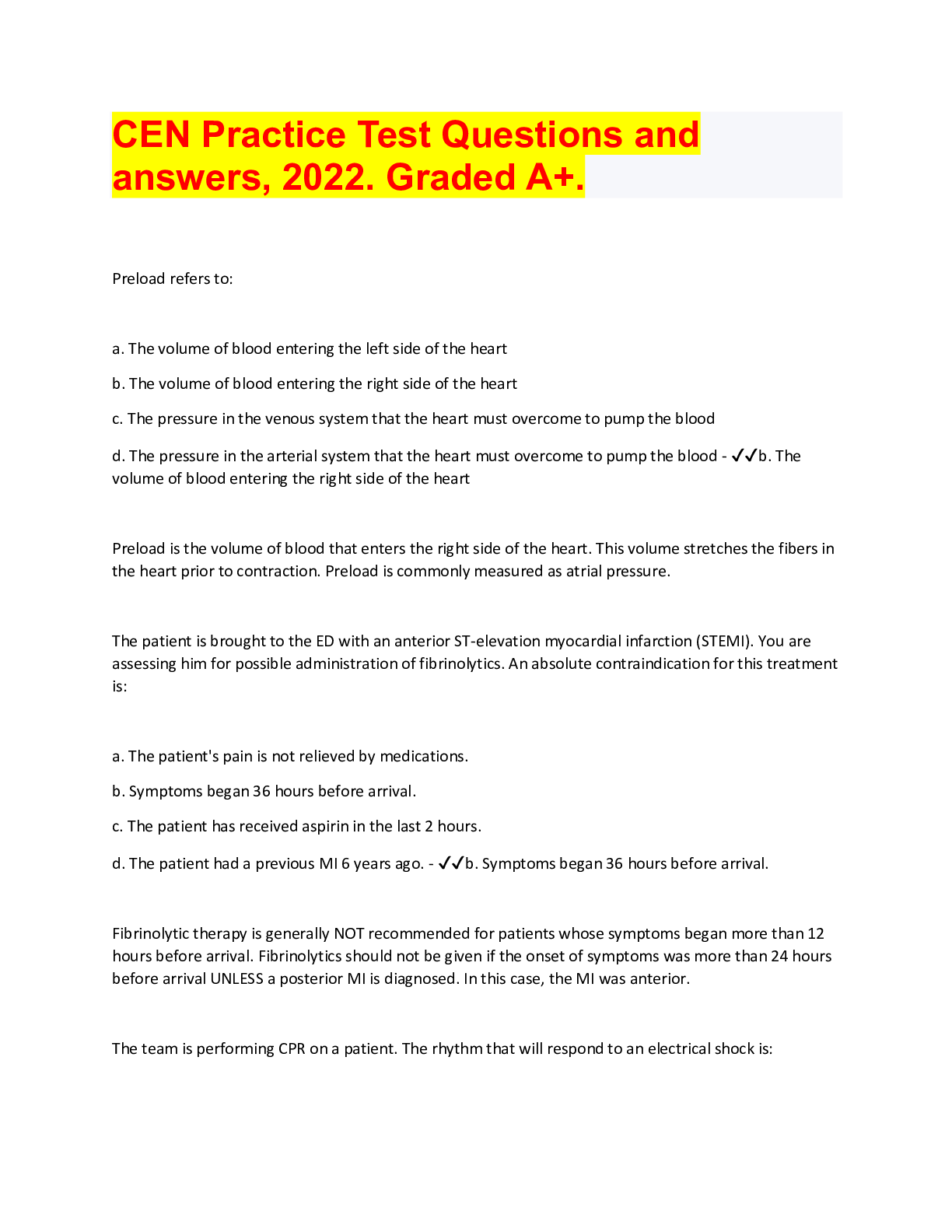
Buy this document to get the full access instantly
Instant Download Access after purchase
Add to cartInstant download
Also available in bundle (1)

CEN bundle, Questions with accurate answers
Comprises of all CEN exams Questions and answers
By bundleHub Solution guider 1 year ago
$32
7
Reviews( 0 )
Document information
Connected school, study & course
About the document
Uploaded On
Sep 01, 2022
Number of pages
21
Written in
Additional information
This document has been written for:
Uploaded
Sep 01, 2022
Downloads
1
Views
178
















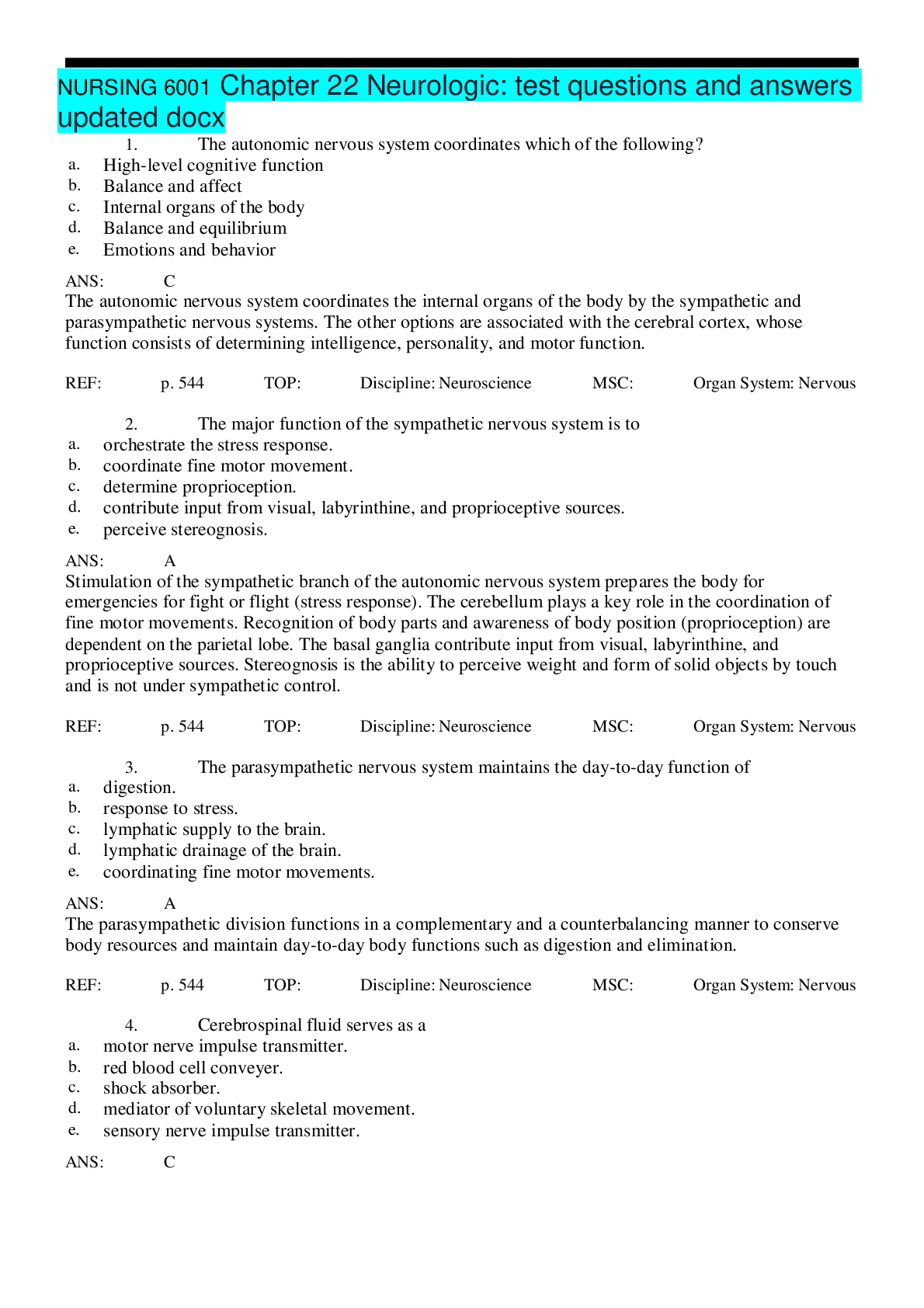

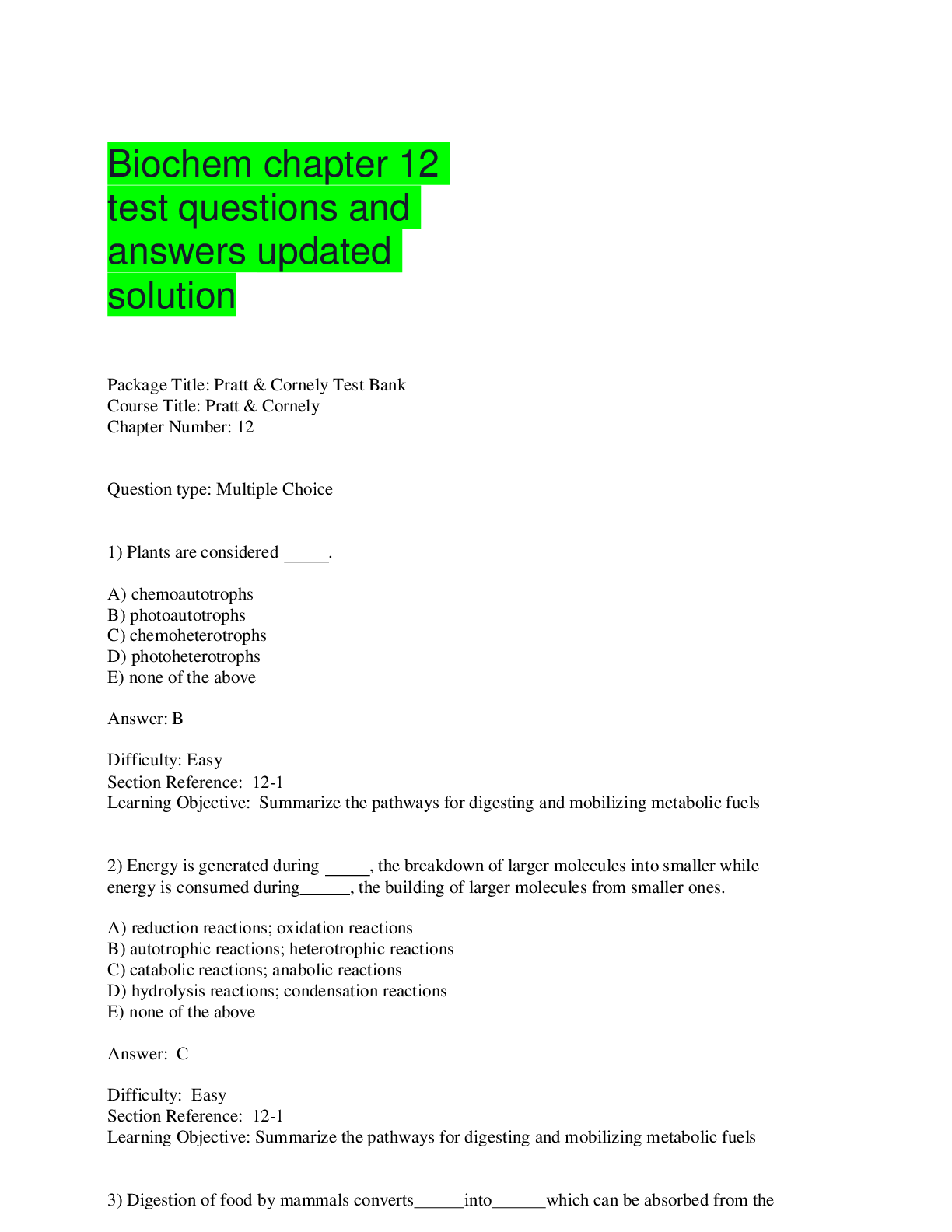
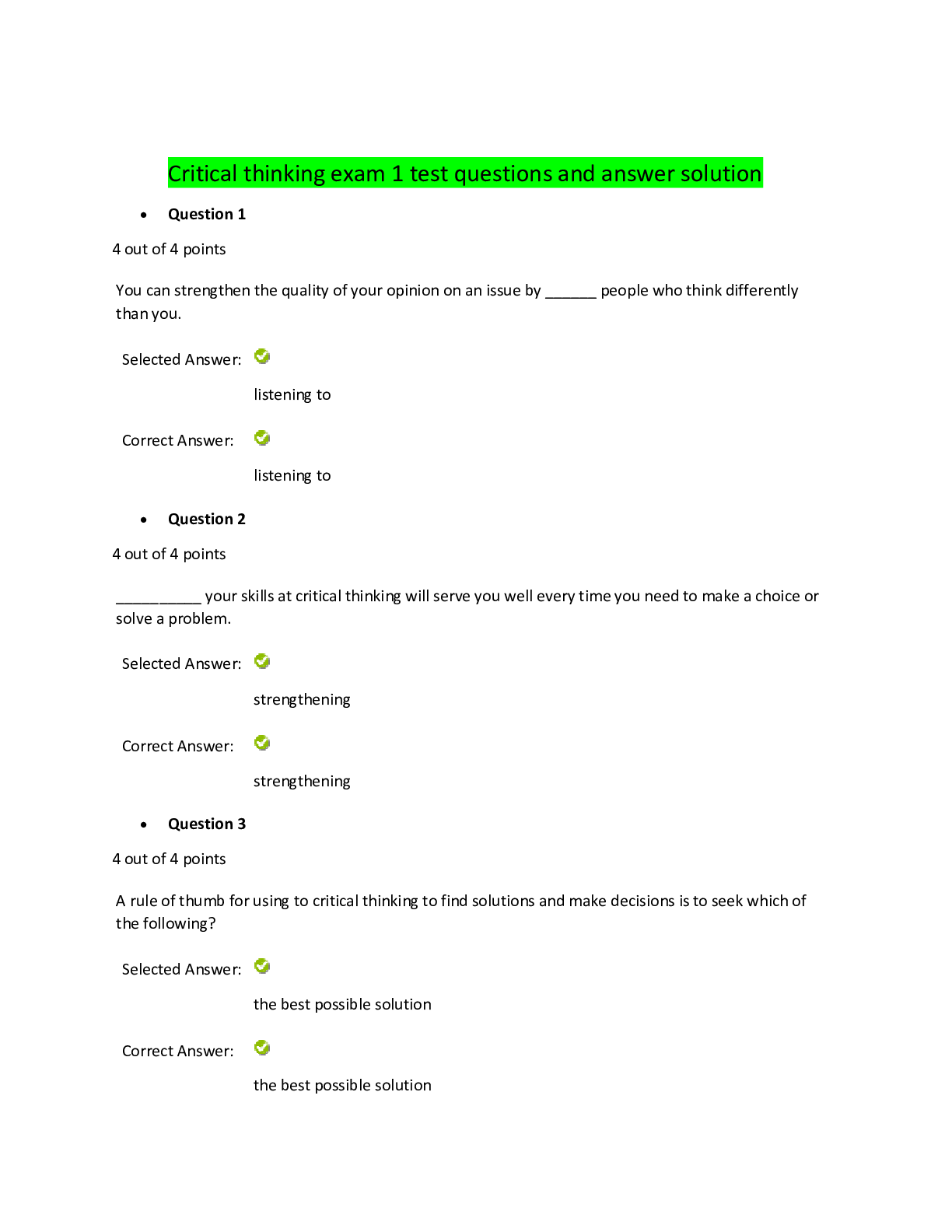
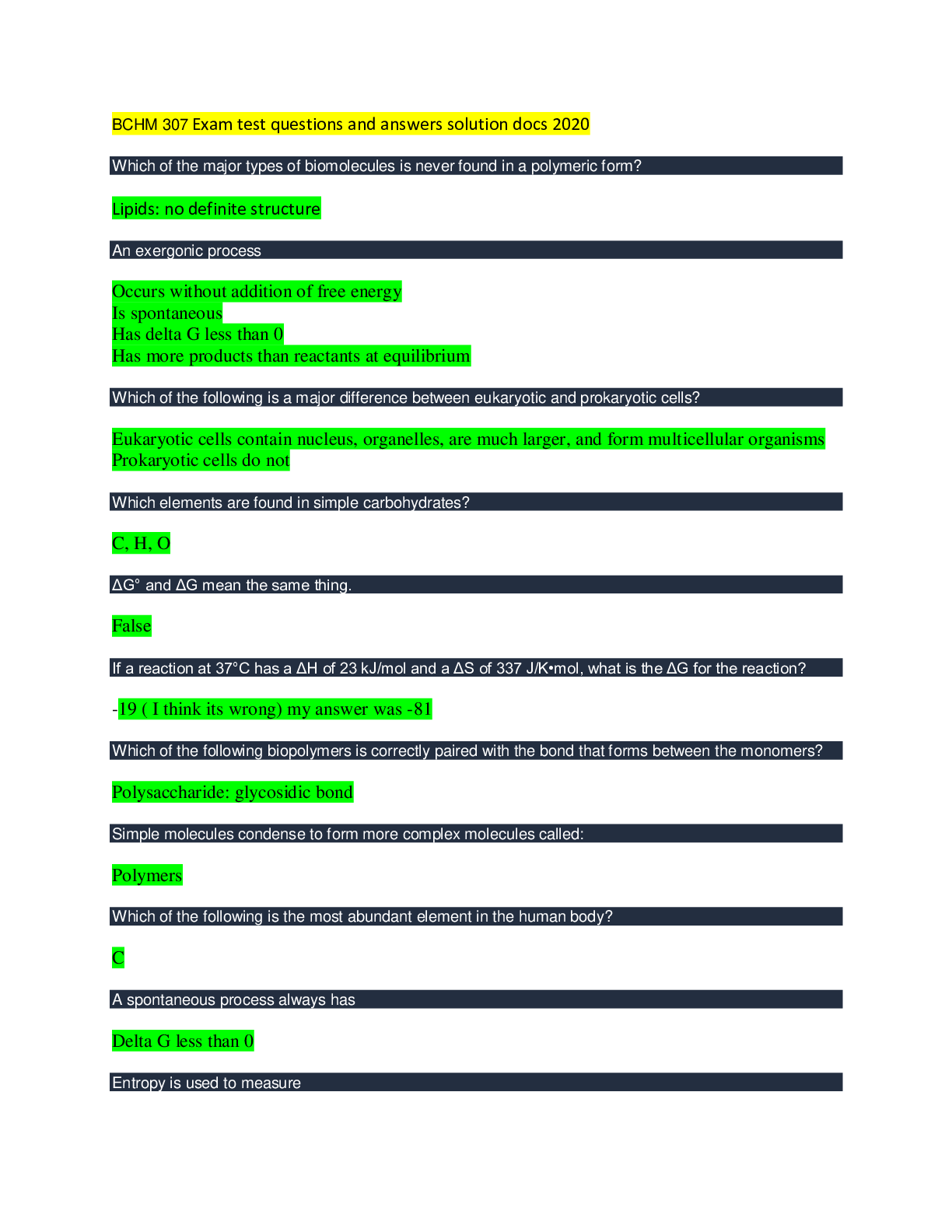

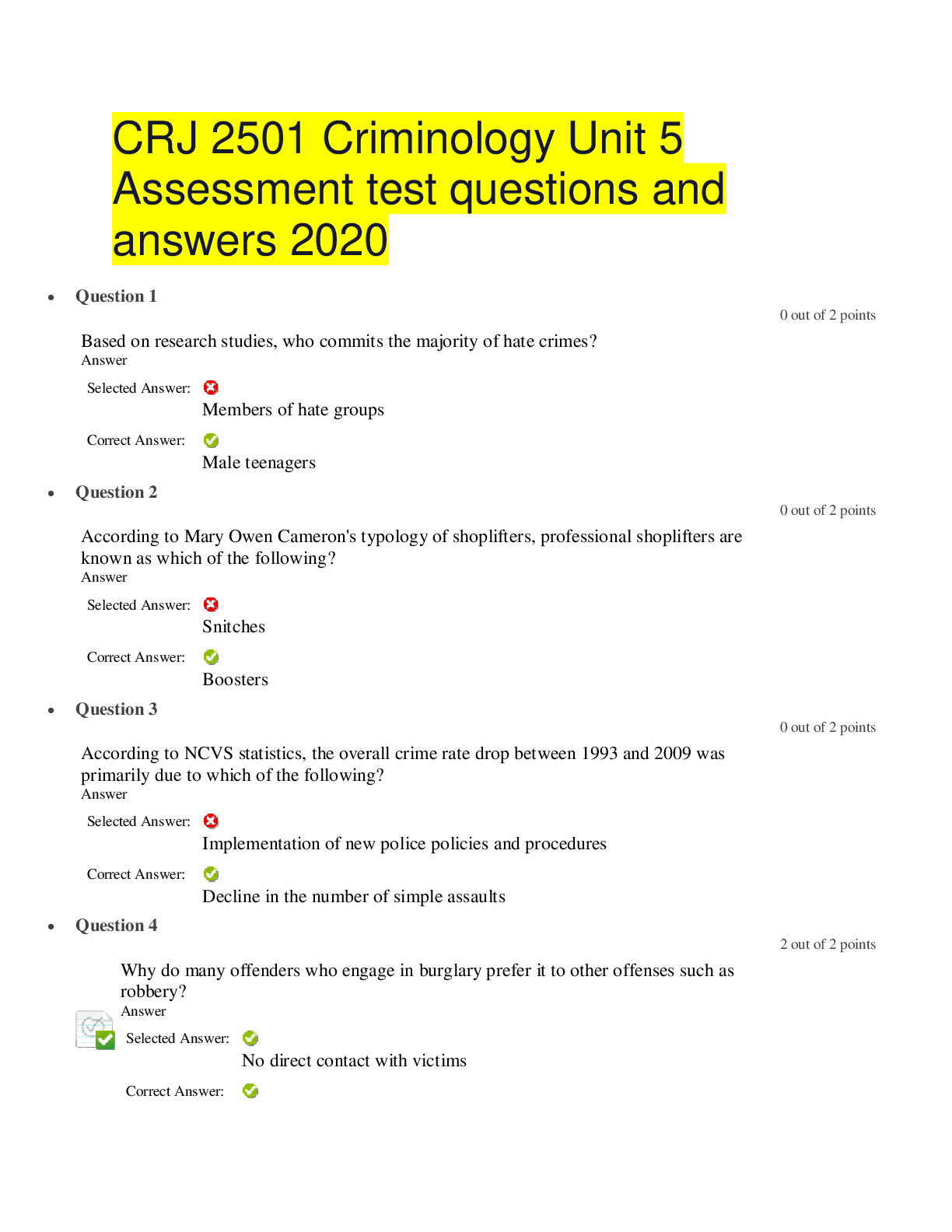
 Med Surg test Questions and Answers with Explanations, 100% Correct, Download to Score A.png)

